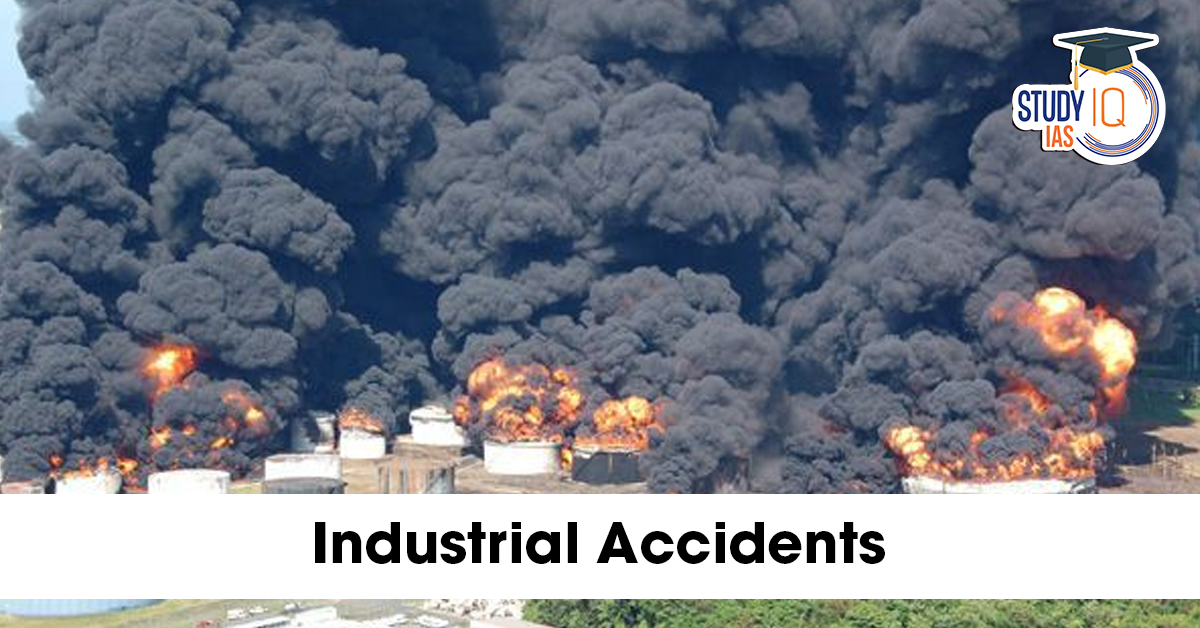Table of Contents
Context: Recent explosions at Sigachi Industries in Telangana and the firecracker unit disaster in Tamil Nadu are not isolated incidents but manifestations of a deeper, persistent national crisis.
Severity of Industrial Accidents in India
- High Casualty Rates: At least 6,500 worker deaths in the last 5 years in factories, construction sites, and mines (~3 fatalities daily).
- Frequent Incidents: One serious accident every two days in registered factories (DGFASLI data).
- Concentration in Certain States: Andhra Pradesh, Tamil Nadu, Gujarat, Maharashtra, Chhattisgarh, and Uttar Pradesh have a high number of mishaps.
- Chemical Accident Hotspots: Over 130 major chemical accidents (2020–2022) with 218 fatalities.
Reasons for Frequent Industrial Accidents
- Regulatory Non-compliance: Factories running without Fire No-Objection Certificates.
- Absence of mandatory firefighting equipment and functional alarms.
- Poor Safety Culture: Safety is treated as a compliance formality, not a core industrial value.
- Lack of permit-to-work systems and hazard identification.
- Inadequate Training: Migrant and contract workers often lack safety orientation and can’t read safety signage.
- Negligence in Infrastructure: Fire exits blocked or locked; improper storage of hazardous materials.
- Weak Accountability: Rare convictions; minimal penalties for safety violations.
- Safety audits have been reduced to tick-box exercises.
- Economic Pressures: Cost-cutting by companies leads to neglect of safety measures.
- Pattern of Neglect Post-Tragedy: Cycle of accident → outrage → media attention → political visit → compensation → silence.
Impact of Industrial Incidents
- Human Cost: Loss of breadwinners; families pushed into trauma and poverty.
- Social marginalisation of victims’ families.
- Economic Loss: Shutdowns, production delays, and damage to plant infrastructure.
- Compensation payouts and legal costs.
- Reputational Damage: Loss of trust in companies and industries.
- Negative perception in domestic and global markets.
- Erosion of Workforce Morale: Reduced motivation and higher attrition among workers.
- National Productivity Loss: A weakened and insecure labour force impacts economic growth.
Measures to Avoid Industrial Accidents
- Strengthen Legal Framework: Introduce corporate manslaughter laws like in South Korea/Singapore to hold top executives criminally liable.
- Enforce Compliance: Mandatory third-party safety audits with public disclosure.
- Strict penalties for operating without safety certifications.
- Safety as Core Value: Integrate safety into industrial design, inspired by Germany/Japan’s practices.
- Worker Training & Inclusion: Multilingual safety training for migrant and contract labour.
- Regular mock drills and hazard awareness programs.
- Digitisation & Transparency: Create a national industrial safety dashboard for real-time risk reporting.
- Whistle-blower protection to encourage reporting of lapses.
- Cultural Change: Shift from a “compliance mindset” to a prevention-first mindset.
- Public campaigns to build awareness about worker safety rights.


 Theaterisation of the Indian Armed Force...
Theaterisation of the Indian Armed Force...
 S-400 Missile Defence System, Features o...
S-400 Missile Defence System, Features o...
 India’s Fighter Jet Conundrum, Current...
India’s Fighter Jet Conundrum, Current...

























